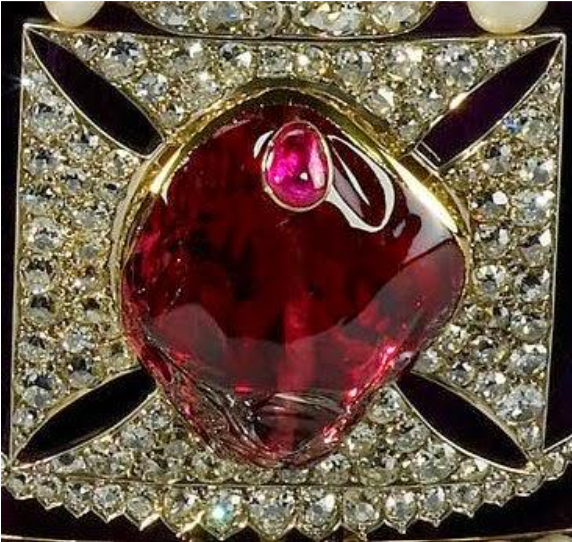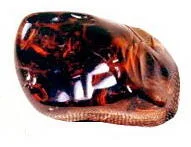Black Prince rubis, an undercover spinel
- lucilledaver1
- Jun 17, 2024
- 5 min read

Introduction
From Afghanistan to British Tower of London, the Black Prince's ruby has made its way through time and lore. Despite its name, it is a red spinel weighing around 170 ct that has belonged to the crown jewels of the United Kingdom since it was acquired in 1367 by Edward the Prince of Wales, also known as the Black Prince for the black armour he wore on the battlefield. In 1569, during Elizabeth I reign, it was renamed the Black Prince's Ruby in his honour.
The spinel is uncut, set in its rough form as a 5-cm-irregular octahedron with rounded edges, with a beautiful bright pigeon-blood-red colour. The stone has a drill hole in one corner, revealing that it was used as a pearl at some point. A small ruby now serves to plug the drill hole opening. The spinel now occupies the front of the Imperial State Crown, made for the coronation of George VI in 1937 by the Crown jeweller Garrard & Co. It is a replica of the Imperial Crown created for Queen Victoria in 1838, with a lighter, more comfortable mounting. On display at the Tower of London.
Imperial State Crown on display at the Tower of London, zoom on the Black Prince ruby (170ct spinel)
Source and beginning of the imposture
The gem probably comes from Kuh-i-Lal, part of the Badakhshan mining region (between present-day Tajikistan and Afghanistan). The ruby/spinel mines of Afghanistan have been mentioned in the Arabic writings of numerous travellers since the 10th century. These red stones, mistaken for rubies are called balas rubies. The name comes from the deformation of Badakhsan into Balakhsh, then Balas. In the late 1980s, huge translucent purplish-pink spinels measuring over 20 cm were mined in the Pamir mountains of Tajikistan, close to the Chinese border. It is not known whether the mine that produced these specimens is the same as the one in Badakhshan, as there are no gemological descriptions of rubies or spinels from Badakhshan, mainly because there are no 20th-century eyewitness accounts of these mines and their locations. The Afghan rubies mined today are small, pinkish in colour and are mostly confined to the Jagdalek mines in the Kabul province of Afghanistan.

Major gem deposits of central Asia. Corundum is found at Sumjam (India), Hunza (Pakistan), Jegdalek (Afghanistan) and Gharan (Afghanistan/Tajikistan), as well as along the China/Tajikistan border. (Map: R.W. Hughes).
From Persia to the Black Prince
There is no record of the year it was mined, nor of its first owners. The first historical mention of the gem dates back to 1362, when Peter I of Castile, known as Peter the Cruel, allied with Prince Mohammed of Granada and seized the treasure of Abu Saïd, Moorish prince and Nasrid emir of Granada, after slaughtering him, including three egg-sized Balas rubies.
In 1366, Peter the Cruel was driven out of Spain by his half-brother Henry II. That same year, he signed the Treaty of Libourne with the Black Prince and, Charles the Bad, King of Navarre. The treaty stipulated that they both would provide Peter the Cruel with military and financial assistance to regain his throne, in exchange for territory and money. In 1367, Peter the Cruel regained his throne, but was unable to pay off his debt. He therefore exchanged the enormous, egg-sized “ruby” for the Black Prince, and made its entry into the crown jewels of the British monarchy.
Between war wounds, theft and fire
During the Hundred Years' War, the Black Prince's Ruby was described at the Battle of Azincourt on October 25, 1415, set in a gold crown over Henry V's helmet, accompanied by pearls and precious stones. During the battle, the King of England was violently struck on his helmet and narrowly escaped death. A small fragment of the spinel was broken off and lost on the battlefield. A French prisoner named Gaucourt informs the King that he knows where to find the fragment, and wishes to exchange the information for his release. Gaucourt finds the fragment, but will never be set free again! This move gave birth to the legend of the protective stone, and from then on, successive sovereigns of all houses had the stone mounted on their respective crowns. On August 22, 1485, Richard III is said to have worn it on his helmet during the Battle of Bosworth. Then, in the early 17th century, James I had the Black Prince ruby set into the royal crown.
Between 1653 and 1658, the rebel Olivier Cromwell seized power, established the Commonwealth of Ireland, England and Scotland and ordered the removal of the Crown Jewels: one part was sold, the other destroyed. Traces of the gem are lost until 1660, when it is bought by an unknown man, who sells it to Charles II after the restoration of the Stuarts, bringing it back to the crown jewels of UK. Its repose was not so fortunate, as the gem narrowly escaped the spectacular theft attempt by Colonel Blood in 1671, the Tower of London fire of 1841 and German raids during the Second World War.
It's important to note, however, that although this story has been counted many times, the link with the Black Prince was only suggested in the 1760s, based on an unsubstantiated, and later disputed, identification of the gem in a portrait. Whether or not it belonged to the mythical Black Prince, there are nevertheless numerous written records of the Spanish jewel ruby balas inscribed in the English crown jewel registers during the valuation of the Jewels of Spain in ca. 1377. After the battle of Azincourt, the broken piece subsequently made it easier to trace the gem, and its journey has been traced with certainty since 1660 after its return to the crown jewels.

Portrait for the Coronation of Queen Victoria by George Hayter (detail), wearing the new Imperial State Crown made for her by the Crown Jewellers Rundell and Bridge, with 3093 gems, with the Black Prince’s Ruby at the front.
Lifted imposture and other famous balas rubies
Rubies and spinels are mineralogically very close (Al2O3 and MgAl2O4 respectively), and in addition to having a very similar colour, they are generally found in the same deposits. As a result, these two types of red gem have long been confused and referred to as rubies. This misidentification continued until the second half of the 18th century. It was in 1783 that French mineralogist Louis Rom de Lisle identified spinel as a mineral distinct from ruby. Following his analysis, many of the “rubies” in crown jewels of monarchs were identified as spinels.
Among the finest specimens is the Ruby of Catherine the great set in 1762 in the Russian imperial crown (398 ct) identified as spinel in 1783 by Louis Rom de Lisle. the `Timur’s Timur` (352.5 ct) was set in 1849 in a necklace for Queen Victoria and identified as a spinel in 1851. In Asia, the Samarian spinel (500 ct), is the largest spinel known to date. It belonged to Jehangir, the Mughal emperor of India, ca. 1650s, and is now in the Iranian Crown Treasury. The Imperial Mughal Necklace with 11 spinels for a total of 1131 ct sold at Christie's in 2011 for $5 million.
(1) The Great Catherine Ruby set in 1762 in the Russian Imperial Crown (398 ct)
(2) Timur Ruby (352.5 ct) set in 1849 in a necklace for Queen Victoria
(3) The Samarian spinel (500 ct), in the Iranian Crown Treasury
(4) Imperial Mughal Necklace with 11 spinels for a total of 1131 ct
Long mistaken for ruby, spinel now shines for its own sake, gaining in popularity since the early 2000s.
By Lucille Daver for Jewellery Business magazine (Canada):
References
Afzali, H., 1981. Les resources d'hydrocarbures, de métaux et de substances utiles de l'Afghanistan: aperçu générál. Chronique de la Recherche Minière, No. 460, 29-49, RWHL*.
Blair, C. (1998). The Crown Jewels: the history of the coronation regalia in the Jewel House of the Tower of London. Stationery Office.
Hughes, R. W. (1994). The rubies and spinels of Afghanistan: A brief history. Journal of Gemmology, 24(4), 256-267.
Hughes, R. W., Manorotkul, W., & Hughes, E. B. (2017). Ruby & sapphire: A gemologist's guide. RWH Publishing.
Ogden, J. M. (2020). The Black Prince’s Ruby: Investigating the Legend. Journal of Gemmology, 37(4).











Comments